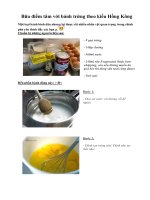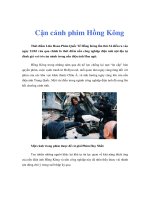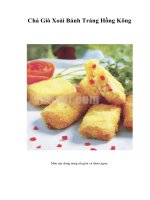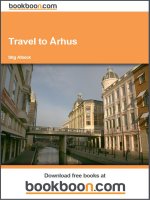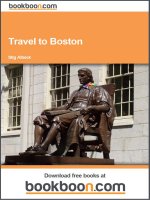Travel to Hong Kong pot
Bạn đang xem bản rút gọn của tài liệu. Xem và tải ngay bản đầy đủ của tài liệu tại đây (4 MB, 44 trang )
Download free ebooks at bookboon.com
Download free ebooks at bookboon.com
Hong Kong
© 2008 Stig Albeck & Ventus Publishing ApS
Translation: Liz Bramsen
All rights and copyright relating to the content of this
book are the property of Ventus Publishing ApS, and/or its
suppliers. Content from ths book, may not be reproduced
in any shape or form without prior written permission from
Ventus Publishing ApS.
Quoting this book is allowed when clear references are made,
in relation to reviews are allowed.
ISBN 978-87-7061-278-4
1st edition
Pictures and illustrations in this book are reproduced according
to agreement with the following copyright owners
Stig Albeck, Hong Kong Museum of Art & Brian McMorrow.
The stated prices and opening hours are indicative and may
have be subject to change after this book was published.
Download free ebooks at bookboon.com
Download free ebooks at bookboon.com
Hong Kong
5
A visit to Hong Kong/佭␃
www.discoverhongkong.com
www.cnto.org
The Hong Kong metropolis is an extremely exciting
city to visit and it has fascinated the millions of
travelers that go there to experience its many unique
contrasts.
Hong Kong is Chinese, but is also influenced by the
more than 150 years of British rule, which ended in
1997. Between the skyscrapers, one finds small
buildings made in the finest colonial architectural
style, providing living proof of the city’s history.
Hong Kong offers a colossal range of activities,
modern business areas, and beautiful nature.
The city is also filled with shopping
opportunities, the delicacies of the Cantonese
cuisine and ancient Chinese culture.
Hong Kong itself is mainly composed of Hong
Kong Island and Kowloon, and the two
combined offer both metropolitan atmosphere,
lovely bathing beaches and wild nature. Nearby
is Macau, where the distinct Portuguese touch
still left behind from colonial times also creates a
unique experience.
Have a good trip!
A visit to Hong Kong
Download free ebooks at bookboon.com
Hong Kong
6
Historical outline
Even in prehistoric times, there were dwellings in
the Hong Kong area, but thousands of years were
to pass before the area began to develop further.
With the opening of the Silk Road, which was at its
height from about 200 BC to the year 950, the
Chinese territory experienced a general
development.
When Genghis Khan invaded China from the north
around the year 1200, there was a big increase in the
population of Hong Kong due to the numerous
refugees from the Mongolian invasion in the other
Chinese regions. In 1300, Hong Kong was officially
founded as a Chinese city.
The first European to visit Hong Kong was Jorge
Álvares, a Portuguese merchant who traded with the
Chinese. His trade brought him there in 1513, and
from then on, Portuguese traders visited the city
regularly.
In 1840, Hong Kong became one of the centers of
the Opium War between China and England. The
Chinese administration in Peking demanded that the
import of opium cease and all the established stores
of opium were destroyed.
In response, on January 20, 1841, Charles Elliott
declared Hong Kong a British crown colony, began
to sell land and thus to re-inhabit Hong Kong
Island. After some disputes and difficulties, Henry
Pottinger took over the leadership of the island, and
under him, the British holdings were expanded to
other cities on the Chinese coast; among them was
Shanghai. Just as they were about to take over
Nanking, a peace agreement was reached and the
Opium War ended.
One of the results of the peace agreement of
Nanking was that China surrendered Hong Kong to
England, and on June 16, 1843, Henry Pottinger
was appointed the first British governor of Hong
Kong. During the same year, China got trade
rights in Hong Kong.
In 1858, the second Opium War broke out, and,
after numerous skirmishes, ended in 1860 with a
settlement in Peking giving England the
southern part of the mainland, present-day
Kowloon.
The last decades of the 1800s were a period of
great growth for the city. A cable car network,
the Victoria Peak Tram, was built, and railroad
connections to Canton were opened. In 1891,
the Hong Kong dollar was introduced.
In 1898, the last expansion of Hong Kong’s
territory took place with the 99-year British lease
agreement for the so-called New Territories,
consisting of the mainland north of Kowloon
and 236 islands. The new additions of land made
it possible for the British to develop the city into
the modern center that it still is today.
In 1941, Hong Kong was invaded by Japanese
troops and after 16 days, the city surrendered. A
large part of the population left for Macau. In
1945, Hong Kong’s British rule was re-
established. Just a few years later, in 1949, when
Mao founded the People’s Republic of China,
supporters of Chiang Kai-Shek left China, many
of them for Hong Kong, thus increasing the
population of the small land area even further.
In 1956, Hong Kong came under regional home
rule, still under the British crown, but with
greatly increased local authority.
The following decades saw the beginning of
Hong Kong’s explosive period of economic
growth. It began with the establishment of a
large textile industry that could compete with
the European producers, especially in terms of
hourly wages.
Historical outline
Download free ebooks at bookboon.com
Hong Kong
7
After the textile industry, trade and industry in
Hong Kong changed in line with the economic
success and a strong financial sector developed.
Over a period of only a few years, the city became
one of the richest in the world.
During this time, changes also took place in the
cultural and social areas, not least due to the
overweight of Chinese inhabitants – for example,
Cantonese became an official language on the same
level as English. The transport sector also benefited
from large investments – the metro, MTR, was
opened in 1980, and eleven years later came plans
for the modern airport, Chek Lap Kok.
In the beginning of the 1980s, China and
England began negotiating British withdrawal
from the area after the lease agreement expired.
In 1984, an agreement was signed returning all
of Hong Kong to China in 1997. Under the
agreement, Hong Kong’s status and system
would continue partially unchanged until 2047.
However, the city would be subject to Chinese
territorial borders, defense rules and foreign
policy immediately after 1997.
On July 1, 1997, Hong Kong became Chinese
once again, and since then the city has become
increasingly integrated into the present unique
period of growth in China – for example, heavy
investments have been made in Hong Kong’s
film industry.
Historical outline
Download free ebooks at bookboon.com
Please click the advert
Hong Kong
8
Tour 1: Hong Kong
1. The Sheung Wan and Western
Districts/Ϟ⪄ och 㽓⪄
MTR: Sheung Wan/Ϟ
Ϟ⪄
The Sheung Wan and Western districts hold
historical significance for Hong Kong. It was in
Possession Street that the English first raised the
Union Jack in 1841. During the same year, more
and more Chinese immigrants began to settle there
and today, the area is still the best example of a
traditional Chinatown within Hong Kong.
2. The University of Hong Kong/
佭␃ᅌ
Pok Fu Lam Road
www.hku.hk
MTR: Sheung Wan/
Ϟ⪄
The university on Hong Kong Island is the
oldest one in Hong Kong. The lovely main
building was built in 1912 in colonial style.
Among the many famous graduates of the
university is Sun Yat-sen, the first president of
the Chinese republic.
In the university museum, Chinese antiques and
works of art can be seen; among them is the
world’s largest collection of bronze objects from
the Yuan dynasty.
Tour 1: Hong Kong
Download free ebooks at bookboon.com
Hong Kong
9
3. The Western Market Building/㽓␃ජ
323 Des Voeux Road Central
MTR: Sheung Wan/Ϟ
Ϟ⪄
Hong Kong’s market building was built in 1906 in
Edwardian style. After a thorough renovation, the
market reopened in 1991. A visit here is a must – in
the many small shops, one can buy Chinese
handicrafts.
4. The Man Mo Temple/
Man Mo Temple/᭛℺ᒳ
124-126 Hollywood Road
MTR: Sheung Wan/
Ϟ⪄
The Man Mo Temple is one of Hong Kong’s oldest.
It was built in 1847. The Temple’s name stems from
Man (the god of literature) and Mo (the god of war),
but the temple itself is a beautiful, peaceful oasis in
the midst of the surrounding city environs.
5. The Duddell Street Steps/
Ё⪄䛑⠍߽㸫䱢
Duddell Street
MTR: Central/
Ё⪄
Between Duddell Street and Ice House Street, there
is a set of fine stone stairs. All along the sides of the
staircase, the last remaining gas lamps in the city are
placed. They were set up in 1875 and stand there
still, spreading a special, romantic atmosphere from
the past and a great contrast to modern Hong Kong.
6. The Governor’s Residence/
佭␃⾂䊧ᑰ
Upper Albert Road
MTR: Central/
Ё⪄
In the Mid-Levels Garden Park, the former
official residence of the British governor in
Hong Kong is situated. The governor’s
residence was built in 1855 and converted by the
Japanese during World War II. Twenty-five
British governors lived here until 1997, when
Hong Kong was handed over to China.
Today the governor’s residence is used for
concerts and other entertainment programs.
Outside of the residence, one can enjoy the
lovely garden with its rhododendrons and
azaleas, not to mention many other attractive
flowers.
7. The Former French Mission
Building/ࠡ⊩ڇ䘧᳗ῧ
1 Battery Path
MTR: Central/
Ё⪄
Among Hong Kong’s skyscrapers in the Central
District, one finds this red brick building in
colonial style from the 1800s, which was bought
by French missionaries in 1915. With its wooden
shutters and cast-iron ornaments, the building is
typical of French buildings of the time. Today, it
houses part of the Hong Kong Court of Final
Appeal.
8. Victoria Peak/ᑇቅ䷖
Peak Road
www.thepeak.com.hk
www.madame-tussauds.com.hk
MTR: Central/
Ё⪄
Tour 1: Hong Kong
Download free ebooks at bookboon.com
Hong Kong
10
Victoria Peak is one of Hong Kong’s most visited
spots. Its placement at the top of the mountain on
Hong Kong Island provides a fantastic view out
over the entire city. It is recommended that one
make the journey upwards in the hours just before
sunset and then stay on the peak until after nightfall.
The view at both points in time is unforgettable.
Victoria Peak is also the starting point for a number
of footpaths, which give one the possibility of
experiencing Hong Kong outside the metropolis
area. One of them gives a fine view of the southern
side of the island and the ocean there.
In the unique tower on Victoria Peak itself one
finds shops, restaurants and Madam Tussaud’s
Wax Museum, which contains replicas of about
100 well-known personalities, among them
Hong Kong’s own Jackie Chan.
The Peak Tram/ቅ䷖㑰䒞 takes you to Victoria
Peak from the terminal at Garden Road. It is a
cable-car route established in 1888. The tram
climbs 373 meters upwards, and you get an
incredible view looking out from the right side
of the wagons.
Tour 1: Hong Kong
Download free ebooks at bookboon.com
Hong Kong
11
Tour 2: Hong Kong
9. St. John’s Cathedral/㘪㋘㗄ᑻූ
4-8 Garden Road
www.stjohnscathedral.org.hk
MTR: Central/Ё
Ё⪄
/Admiralty/
䞥䧬
St. John’s Cathedral is believed to be the oldest
Anglican church in the Far East. It was built in 1849
in a style that blends English architecture of the
1200s with decorated Gothic architecture.
10. The Bank of China Tower/Ё䡔ᒜ
1 Garden Road
MTR: Central/
Ё⪄
/Admiralty/
䞥䧬
The impressive Bank of China Tower is one of
modern Hong Kong’s most striking buildings. The
architect, I. M. Pei, used bamboo as his inspiration.
The building is 70 stories high and recognizable
from all the popular vantage points in the city.
11. Flagstaff House/᮫ᴚሟ
10 Cotton Tree Drive
www.lcsd.gov.hk/ce/museum
MTR: Admiralty/
䞥䧬
The Flagstaff House mansion in Hong Kong
Park was built in 1846 as a residence for the
British commander. It held that status until 1932.
Today, the lovely house is a museum for tea sets.
12. The Central Plaza Building/
Ё⪄ᒷจ
18 Harbour Road
www.centralplaza.com.hk
MTR: Wan Chai/
☷Ҩ
Central Plaza’s 78 stories make it one of Hong
Kong’s highest buildings. After nightfall, the
neon light at the top of Central Plaza changes
color every fifteen minutes, thus placing it
among the city’s most noteworthy modern
skyscrapers.
Tour 2: Hong Kong
Download free ebooks at bookboon.com
Please click the advert
Hong Kong
12
13. The Hong Kong Convention &
Exhibition Center /佭␃᳗䅄ሩ㾑Ёᖗ
1 Expo Drive
www.hkcec.com
MTR: Wan Chai/☷
☷Ҩ
Hong Kong’s unique convention and exhibition
center is built on reclaimed land in Victoria Harbor.
Its special roof construction makes it one of Hong
Kong’s landmarks. It was here that the official
ceremony of Hong Kong’s handover to China took
place in 1997.
14. The Tin Hau Temple/Tin Hau
Temple/ৢᇎ
Tin Hau Temple Road 10
MTR: Tin Hau/
ৢ
The little Tin Hau temple was built in the early
1700s by the Tai family. The temple was
originally built to protect a statue of the goddess
of the sea, Tin Hau, which the family is said to
have found along the coast.
15. The Hong Kong Island cable cars
Hong Kong Island
Hong Kong’s picturesque cable cars have
rumbled through the streets of Hong Kong
Island since 1904. A tour from east to west
provides many impressive sights of the lovely
buildings and breathtaking views of natural
scenery in these parts.
Tour 2: Hong Kong
© Deloitte & Touche LLP and affiliated entities.
360°
thinking
.
Discover the truth at www.deloitte.ca/careers
© Deloitte & Touche LLP and affiliated entities.
360°
thinking
.
Discover the truth at www.deloitte.ca/careers
© Deloitte & Touche LLP and affiliated entities.
360°
thinking
.
Discover the truth at www.deloitte.ca/careers
© Deloitte & Touche LLP and affiliated entities.
360°
thinking
.
Discover the truth at www.deloitte.ca/careers
Download free ebooks at bookboon.com
Hong Kong
13
Tour 2: Hong Kong
Download free ebooks at bookboon.com
Hong Kong
14
Tour 3: Hong Kong
16. Star Ferry/᯳ᇣ䓾
www.starferry.com.hk
MTR: Tsim Sha Tsui/ᇪ
ᇪ≭
/Central/
Ё⪄
Since 1898, the Star Ferry has sailed the eight-
minute route across Victoria Harbor, thus
connecting Hong Kong Island to Tsim Sha Tsui.
The tour is a must for every visitor to Hong Kong.
The view from the ferry of modern, beautifully
situated Hong Kong and the special atmosphere on
board are incomparable.
17. The Railway Clock Tower/
ࠡбᒷ䨉䏃䧬ῧ
Waterfront Promenade
MTR: Tsim Sha Tsui/
ᇪ≭
The striking Railway Clock Tower at the
waterfront near Star Ferries was erected in 1921
as part of the earlier main railway station of the
Kowloon-Canton railway. Today, the area near
the clock tower is a good starting point for a
walk along the pleasant waterfront promenade.
18. The Marine Police
Headquarters/ࠡ∈䄺㐑䚼
Tsim Sha Tsui Hill
MTR: Tsim Sha Tsui/
ᇪ≭
Hong Kong’s Marine Police have operated out
of this building since the beautiful complex was
finished in 1884. From the two-storey-high
tower in the complex, a signal was given daily at
1:00 pm until 1907, so that the ships could set
their clocks correctly.
19. Hong Kong Cultural Centre/
佭␃᭛࣪Ёᖗ
Salisbury Road 10
www.lcsd.gov.hk/hkcc
MTR: Tsim Sha Tsui/
ᇪ≭
Hong Kong’s unique cultural center was
constructed in 1984. It is the setting of a number
of concerts and exhibitions. It also houses a
couple of the city museums, including the art
museum.
19a. Hong Kong Museum of Art/
佭␃㮱㸧仼
www.lcsd.gov.hk/hkma
Tour 3: Hong Kong
Download free ebooks at bookboon.com
Please click the advert
Hong Kong
15
At the Hong Kong Museum of Art, one finds a very
fine collection of works of art. Especially impressive
are the works representing early Chinese history
during the Han, Ming, and Qing dynasties. There
are also galleries of international art at the museum.
20. Waterfront Promenade/
The Avenue of Stars/᯳ܝ䘧
Waterfront Promenade
www.lcsd.gov.hk/parks
MTR: Tsim Sha Tsui/ᇪ
ᇪ≭
From the Railway Clock Tower, the waterfront
promenade goes eastward along the water. In
addition to viewing some of Kowloon’s modern
buildings, one can see an unforgettable sight –
Victoria Harbor and the fascinating skyline of
Hong Kong Island. The Avenue of Stars is the
first street in Asia where movie stars have placed
their names and imprints.
21. The Museum of History/
佭␃⅋म⠽仼
Chatham Road South 100
www.lcsd.gov.hk/hkmh
MTR: Tsim Sha Tsui/
ᇪ≭
Hong Kong’s Museum of History depicts the
history of the city and the southern Chinese area
throughout the last 6,000 years in its exclusive
permanent exhibition. The museum exhibits
archaeological finds and has departments for
ethnography and natural history, so one gets a
lot out of the 7,000 square meters of space the
museum holds.
Tour 3: Hong Kong
Increase your impact with MSM Executive Education
For more information, visit www.msm.nl or contact us at +31 43 38 70 808
or via
the globally networked management school
For more information, visit www.msm.nl or contact us at +31 43 38 70 808 or via
For almost 60 years Maastricht School of Management has been enhancing the management capacity
of professionals and organizations around the world through state-of-the-art management education.
Our broad range of Open Enrollment Executive Programs offers you a unique interactive, stimulating and
multicultural learning experience.
Be prepared for tomorrow’s management challenges and apply today.
Executive Education-170x115-B2.indd 1 18-08-11 15:13
Download free ebooks at bookboon.com
Hong Kong
16
22. The Peninsula Hotel/ञዊ䜦ᑫ
Salisbury Road/Nathan Road
MTR: Tsim Sha Tsui/ᇪ
ᇪ≭
The world-renowned Peninsula Hotel with its
fantastic lobby was built in 1928 (the tall central
building, however, was added later). It is one of the
best places in Hong Kong to enjoy a classic English
afternoon tea.
23. The Golden Mile/䞥ඳ
Nathan Road
MTR: Tsim Sha Tsui/
ᇪ≭
/Jordan/
Ԥᬺ
In Kowloon’s central district, Tsim Sha Tsui, we
find Nathan Road, named after the British
governor who laid the plan for the street.
Nathan Road, with its many neon-lit shops,
hotels, restaurants and nightclubs, is known as
the Golden Mile. The Golden Mile gives visitors
a good impression of the hectic daily life of
Kowloon.
24. Kowloon Park/б啡݀೦
Nathan Road/Austin Road
www.lcsd.gov.hk/parks
MTR: Tsim Sha Tsui/
ᇪ≭
Kowloon Park is a beautifully landscaped oasis
in the middle of the Kowloon district. The park
covers about 34 acres and was created in an area
that used to house military barracks. In the park,
one can see sculptures made by local sculptors, a
bronze statue made by Scottish Eduardo
Paolozzi, a Chinese garden and an interesting
labyrinth. In a corner of Kowloon Park is the
Kowloon Mosque and Islamic Centre, built in
white marble in Oriental style.
25. The Hong Kong Observatory/
佭␃᭛ৄ
Nathan Road 134A
www.hko.gov.hk
MTR: Tsim Sha Tsui/
ᇪ≭
Tour 3: Hong Kong
Download free ebooks at bookboon.com
Hong Kong
17
Hong Kong’s observatory was built in 1883 in
colonial style with arches and verandahs. The area’s
meteorological measurements continue to be taken
from the lovely building. The observatory can be
visited by groups if an appointment is made in
advance.
26. The Kowloon British School/
ࠡб啡㣅スᅌ᷵
Nathan Road 136
MTR: Tsim Sha Tsui/ᇪ
ᇪ≭キ
Once a school for English children, the
Kowloon British School was built in 1902 in
Victorian style. Today, it is used for exhibitions
arranged by the Antiquities and Monuments
Office.
Tour 3: Hong Kong
Download free ebooks at bookboon.com
Please click the advert
Hong Kong
18
Tour 4: Hong Kong
27. The Jade Market/⥝఼Ꮦจ
Kansu, Canton & Battery Street
MTR: Jordan/Ԥ
Ԥᬺ
At Kowloon’s renowned jade market, jade of every
type is sold. At the many booths, one can purchase
jewelry and other objects in an authentic Chinese
street-market environment. Nearby is the Tin Hau
Temple from the late 1800s.
28. The Mong Kok District/ᯎ㾦
MTR: Mong Kok/
ᯎ㾦
The Mong Kok district north of Tsim Sha Tsui
is one of Hong Kong’s most densely populated
areas. A stroll here gives a clear impression of
the intense atmosphere of this extremely active
trading area. In the area, there are a number of
different markets, among them the well-known
bird market.
29. The Kowloon Walled City /
б啡ජᆼ
Kowloon Walled City Park
www.lcsd.gov.hk/parks
MTR: Lok Fu/
ῖᆠ
The Kowloon Walled City was built by the Qing
government in 1847 as a military outpost facing
south towards the English of the area. The area
remained on Chinese hands until 1899, when the
English invaded the walled-in city. In 1987, the
city contained a large slum area, and a decision
was made to tear it down. Today one can see the
remains of the city’s entrance gates to the east
and the south as well as the restored Yamen
building.
Tour 4: Hong Kong
Get “Bookboon’s Free Media Advice”
See the light!
The sooner you realize we are right,
the sooner your life will get better!
A bit over the top? Yes we know!
We are just that sure that we can make your
media activities more effective.
Download free ebooks at bookboon.com
Hong Kong
19
30. The Wong Tai Sin Temple/
㡆೦咗ҭ⼴
Lung Cheung Road
MTR: Wong Tai Sin/咗
咗ҭ
Wong Tai Sin is a traditionally built Chinese temple
with red pillars, a curved golden roof and colorful
decorations in wood. Believers, who wish to seek
advice and relief from health problems or financial
difficulties, visit the temple.
The present-day Wong Tai Sin Temple was built in
1956, but the painting of the shepherd, Wong Tai
Sin, was already brought to Hong Kong in 1915. In
the temple, you can have your fortune told.
31. Diamond Hill/䩑ቅ
Diamond Hill
MTR: Diamond Hill/
䩑ቅ
The beautifully renovated convent, Chi Lin (ᖫ
㫂⎼㢥), on Diamond Hill, is kept in traditional
Chinese style. The stillness of the place makes a
sharp contrast to modern Hong Kong, and the
convent is like a living museum of the Tang
dynasty, which gave inspiration to its
construction. Make sure to visit the Pagoda with
the 10,000 Buddhas nearby the convent as well.
Tour 4: Hong Kong
Download free ebooks at bookboon.com
Hong Kong
20
Day Tours from
Hong Kong
32. The Sam Tung Uk Village/ϝẳሟ
Tsuen Wan
www.heritagemuseum.gov.hk
MTR: Tsuen Wan/㤗
㤗☷
The square Sam Tung Uk village was built in 1786.
The little village was constructed by the Chan clan,
and it is fascinating to see the way it is built with
walls surrounding it. The village was renovated and
opened as a museum in 1987.
33. Tai Po/ඨ
Tai Po
Station: Tai Po/
ඨ
The town of Tai Po in the New Territories is one of
the oldest inhabited places in the Hong Kong area.
Tai Po was extremely wealthy due to pearl fishing.
In recent decades, the town has grown dramatically
but even today, it is still a comfortable, homey place
where one can meet both traditional and modern
China.
33a. The Waterfront Park/
ඨ⍋◅݀೦
www.lcsd.gov.hk/parks
Tai Po’s Waterfront Park is a lovely piece of
landscaping. Here we find the 32.4-meter-high
futuristic tower, which provides a choice view of the
town, the harbor and the surrounding landscape. It
is possible to look across the former border
between Hong Kong and the rest of China. Note
also the unique, fan-shaped arrangement of the
flowerbeds made to resemble a large rainbow – this
can best be seen from the tower.
33b. The Tai Po Market Station/
ඨキ
www.heritagemuseum.gov.hk
Station: Tai Po Market/
ඨ
The train station at the Tai Po Market is different
from the others in the area because it is built in
Chinese style. It was built in 1913 and today an
exciting railway museum stands here.
34. The Po Lin Monastery/ປԯ
Ngong Ping
www.plm.org.hk
Station: Tung Chung/
ᵅ⍠
The Po Lin monastery is placed in a beautiful
area on Lantau Island, 520 meters above sea
level. The monastery is known for its large
bronze Buddha from 1993. The Buddha is 26.4
meters high and weighs 220 tons. It is the largest
of its kind in the world.
The Po Lin monastery itself is also worth seeing.
It is beautiful and gives a fine impression of a
Chinese temple complex. One can try to gain
information on one’s future here – this is done
by means of bamboo sticks.
Near the Po Lin monastery, one can walk along
the Wisdom Path, a replica of a Buddhist prayer,
which is several hundred years old. The Wisdom
Path was laid out in 2002.
Day Tours from Hong Kong
Download free ebooks at bookboon.com
Please click the advert
Hong Kong
21
One can also choose to walk to Lantau Peak – with
its 934 meters it is the Hong Kong area’s next-
highest mountain. From the top, there is a
formidable view of the archipelago - in clear
weather all the way to Macau.
35. Guangzhou/ᒷᎲ
Guangzhou
www.cnto.org/guangzhou.asp
Station: Guangzhou/ᒷ
ᒷᎲ
The metropolis of Guangzhou lies at the mouth of
the Pearl River (Xi Jiang). The town used to be
called Canton and was founded more than 2,000
years ago. Its geographical placement quickly made it a
lively trading port, and in the period from 1757-1842 it
was the only Chinese harbor open to foreign trade.
Guangzhou was the place where Sun Yatsen
worked and where the national Kuomintang party
had its head office. Today, the city is extremely
modern and busy and gives a clear picture of the
explosive development China has been experiencing
in present decades, although it is also filled with
historical locations and monuments.
35a. Yuexiu Gongyuan/Yu
k
xi
s
G
|
ngyu
j
n/
䍞⾔݀ು
Close to the city’s railroad station is the large
park called Yuexio Gongyuan. The park is
beautifully landscaped with numerous lakes and
hills. In the center is the Zhenhailou Tower,
which houses the city museum. The museum
shows relics from Guangzhou’s history. The
tower is a memorial to the seafarer Zheng He,
who went on many voyages to other countries,
including Africa, in the beginning of the 1400s.
35b. The Sun Yatsen Monument and the
Memorial Hall/S
}
n Zh
|
ngsh
v
n J
n
ni
i
nt
j
ng/
ᄭЁቅ㑾ᗉූ
The Sun Yat Sen monument is located on a
hilltop just south of the Yuexio Gongyuan park.
From here, there is a beautiful view over the city
and of the Sun Yatsen Memorial Hall. The
memorial hall was built in the years from 1925
to 1931 and different cultural arrangements are
held there.
Day Tours from Hong Kong
GO T -THE-ENERGY-T O-LEAD.COM
We believe that energy suppliers should be renewable, too. We are therefore looking for enthusiastic
new colleagues with plenty of ideas who want to join RWE in changing the world. Visit us online to find
out what we are offering and how we are working together to ensure the energy of the future.
Download free ebooks at bookboon.com
Hong Kong
22
35c. The Catholic Cathedral/
Sho
o
sh
n
Sh
k
ngx
y
n Ji
i
ot
j
ng/
ᬭᖗᬭූ
Guangzhou’s Catholic Cathedral was built in 1888.
After decades of decay, it was restored in the 1980s.
Today it belongs to the Chinese Catholic Church
35d. The Temple of the Six Banyan Trees/
Li
s
R
q
ng S
n
/
݁Ὡᇎ
This temple is best known for its pagoda, which
is one of the city’s landmarks. The Pagoda is
called the Flower Pagoda/Hua Ta and it was
built in 1097. Inside, the pagoda has 17 stories.
It is possible to go to the top and thus be
rewarded with an interesting view. Here we can
truly see a blend of the old and the new China.
35e. The Chen Family Temple/Ch
l
nji
v
S
n
/
䰜ᆊᇎ
This large and opulently decorated temple
complex was first built in 1894, but rebuilt after
the Cultural Revolution. The temple area is in
classical style, with pagodas, temple gates, a fine
garden and, naturally, the temple buildings
themselves.
Day Tours from Hong Kong
Download free ebooks at bookboon.com
Hong Kong
23
35f. Shamian Island/Shv
v
mi
i
n D
~
o/
≭䴶ቯ
Little Shamian Island by the Pearl River was divided
up into foreign concession areas in the mid-1800s.
Today, one can still enjoy a look at many of the
buildings from colonial times – mainly French ones.
36. Macau/▇䭔
Macau
www.macautourism.gov.mo
Access with the jetfoil from Hong Kong
In 1557, Portugal founded the town and the colony
of Macau. The town belonged to the Portuguese for
442 years until 1999, when it was handed over to
China. Throughout the entire period, Portugal left
its cultural and architectural mark on Macau in a
very charming way. Today it has a unique
atmosphere, which blends Asia with southern
Europe.
It is a nice experience to stroll through the
streets all over town, including the great Senado
Square, Largo do Senado, where the lovely Leal
Senado building from 1784 stands. The façade
was finished in 1876.
Today, all that is left of the large São Paolo
Cathedral from the 1500s is the impressive
façade. The big staircase leading up to the façade
is perhaps what makes this place the most
impressive in Macau.
Near São Paolo is the Monte Fort from the
1620s. In addition to the impressive walls of the
fort, this is also where you will find the Macau
Museum, which depicts the town’s noteworthy
history.
Day Tours from Hong Kong
Download free ebooks at bookboon.com
Please click the advert
Hong Kong
24
Day Tours from Hong Kong
Contact us to hear more
Who is your target group?
And how can we reach them?
At Bookboon, you can segment the exact right
audience for your advertising campaign.
Our eBooks offer in-book advertising spot to reach
the right candidate.
Download free ebooks at bookboon.com
Hong Kong
25
Hong Kong for children
Hong Kong Disneyland/佭␃䖾ሐῖ೦
(Lantau Island):
www.hongkongdisneyland.com
Hong Kong Science Museum
(Science Museum Road):
www.hk.science.museum
Hong Kong Zoological Garden (Victoria Peak):
www.lcsd.gov.hk/parks
The Hong Kong Railway Museum/佭␃䨉䏃म⠽
仼 (Shung Tak Street 13, Tai Po):
www.heritagemuseum.gov.hk
A Symphony of Lights/ᑏᔽ䀴佭∳ (Avenue of
Stars, Waterfront Promenade):
www.tourism.gov.hk/symphony
Ocean Park/⍋⋟݀೦ (Aberdeen):
www.oceanpark.com.hk
Shopping in Hong Kong
Nathan Road, Salisbury Road, Tung Choi Street,
Temple Street, Sai Yeung Choi Street
Festival Walk (80 Tat Chee Avenue):
www.festivalwalk.com.hk
IFC Mall (8 Finance Street):
www.ifc.com.hk
Megabox (Kowloon Bay):
www.megabox.com.hk
New Town Plaza (Shatin Centre Street):
www.newtownplaza.com.hk
Ocean Terminal (3 Canton Road):
www.oceanterminal.com.hk
Pacific Place (88 Queensway):
www.pacificplace.com.hk
Public transportation in Hong Kong
Hong Kong city transport:
www.mtr.com.hk
Hong Kong airport:
www.hongkongairport.com
China’s railways:
www.train.chinamor.cn.net
Timetables for Chinese trains:
www.treehouse.ofb.net/guide/searchtrainst
ations?lang=en
Children / Shopping / Public transportation
